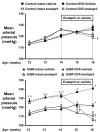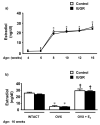Estrogen protects against increased blood pressure in postpubertal female growth restricted offspring
- PMID: 17724277
- PMCID: PMC2850594
- DOI: 10.1161/HYPERTENSIONAHA.107.091785
Estrogen protects against increased blood pressure in postpubertal female growth restricted offspring
Abstract
Placental insufficiency in the rat results in intrauterine growth restriction and development of hypertension in prepubertal male and female growth-restricted offspring. However, after puberty, only male growth-restricted offspring remain hypertensive, whereas female growth-restricted offspring stabilize their blood pressure to levels comparable to adult female controls. Because female rats reach their maximum levels of estrogen at puberty, we hypothesize that estrogen may be a factor involved in the stabilization of blood pressure in adult female growth-restricted offspring. At 10 weeks of age, female control and growth-restricted offspring underwent ovariectomy or sham surgery and insertion of a telemetry probe. Mean arterial pressure was similar at 16 weeks of age between control (123+/-4 mm Hg) and growth-restricted offspring (122+/-2 mm Hg); however, ovariectomy led to a significant increase in blood pressure in growth-restricted offspring (140+/-2 mm Hg; P<0.05 versus intact counterpart) with no significant effect in controls (124+/-1 mm Hg). Estrogen replacement by subcutaneous minipellet initiated at 14 weeks of age in a subset of ovariectomized control and growth-restricted offspring reversed the effect of ovariectomy on blood pressure in growth-restricted offspring at 16 weeks of age (111+/-3 mm Hg; P<0.05 versus ovariectomized counterpart); renin angiotensin system blockade also abolished ovariectomy-induced hypertension in female growth-restricted offspring (106+/-2 mm Hg; P<0.05 versus ovariectomized counterpart). Therefore, sex differences are observed in this model of fetal programmed hypertension, and results from this study suggest that estrogen contributes to normalization of blood pressure in adult female growth-restricted offspring.
Figures





Comment in
-
Mechanisms of fetal programming of adult hypertension: role of sex hormones.Hypertension. 2007 Oct;50(4):605-6. doi: 10.1161/HYPERTENSIONAHA.107.096768. Epub 2007 Aug 27. Hypertension. 2007. PMID: 17724274 No abstract available.
References
-
- Rosamond W, Flegal K, Friday G, Furie K, Go A, Greenlund K, Haase N, Ho M, Howard V, Kissela B, Kittner S, Lloyd-Jones D, McDermott M, Meigs J, Moy C, Nichol G, O'Donnell CJ, Roger V, Rumsfeld J, Sorlie P, Steinberger J, Thom T, Wasserthiel-Smoller S, Hong Y. Heart disease and stroke statistics--2007 update: a report from the American Heart Association Statistics Committee and Stroke Statistics Subcommittee. Circulation. 2007;115:e69–e171. - PubMed
-
- Caulin-Glaser T. Primary Prevention of Hypertension in Women. J Clin Hypertens (Greenwich) 2000;2:204–209. - PubMed
-
- Reckelhoff JF. Gender differences in the regulation of blood pressure. Hypertension. 2001;37:1199–1208. - PubMed
-
- Preston RA. Effects of blood pressure reduction on cardiovascular risk estimates in hypertensive postmenopausal women. Climacteric. 2007;10(Suppl 1):32–41. - PubMed
-
- Oparil S. Women and hypertension: what did we learn from the Women's Health Initiative? Cardiol Rev. 2006;14:267–275. - PubMed
Publication types
MeSH terms
Substances
Grants and funding
LinkOut - more resources
Full Text Sources
Medical

